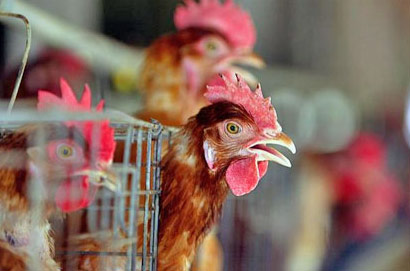Dangerous bird flu epidemic hits Russia's Siberia
It apparently goes about H5N1 virus, which can be transmitted from birds to humans
Four regions of the Novosibirsk region in Russia's Siberia have been quarantined on account of massive mortality of fowl. Valery Mikheyev, the chief sanitary specialist of the region, told Itar Tass that regional emergency services were taking urgent measures to isolate domestic birds from migrant birds that settle on numerous lakes situated in the area of the quarantine. 
The specialist added that there had been no incidents registered in the Novosibirsk region, when humans were infected with the bird flu virus. Scientists say, however, that samples of the bird flu virus in Novosibirsk can be dangerous to people: it goes about the A type of the bird flu virus, subtype H5N1. This virus killed 56 people in Southeast Asia last year. Over one thousand domestic birds have already died at poultry farms of the Novosibirsk region.
Russia's Surgeon General, Gennady Onishchenko, ordered the Flu Research Institute of the Russian Academy of Sciences to prepare recommendations for local healthcare agencies in connection with a possible outbreak of the bird flu pandemic in the Russian Federation.
The Federal Service for Veterinary and Sanitary Control exposed results of its laboratory analysis yesterday. It was revealed that the Novosibirsk region was experiencing the epidemic of H5N1 bird flu virus. The virus transmits from birds to humans – 50 percent of patients die from the infection.
The Russian poultry industry may incur considerable damages because of the current bird flu epidemic. It is noteworthy that Russia is the largest consumer of poultry in the world. Russians eat about two million tons of poultry a year; specialists evaluate the national poultry market at some $6 billion.
There are over 600 poultry farms in Russia. The farms will most likely suffer considerable losses, even if the epidemic in the Novosibirsk region does not spread onto other territories of Russia. Apparently, all Novosibirsk poultry farms will have to destroy their chickens and hens – this is the most efficient method to struggle against the dangerous disease. Specialists say that it may take many months of quarantine and other urgent measures to eliminate the consequences of the epidemic. Thailand was fighting with the bird flu epidemic for about 18 months, when about 30 million birds were destroyed, whereas authorities had to spend tens of millions of dollars to neutralize the raging virus.
Bird flu virus (H5 and H7 viruses are considered most dangerous types) was discovered in the beginning of the 20th century in Italy. Scientists originally believed that the virus was absolutely harmless to humans.
The first incident, when a human being was infected with bird flu, was registered in Hong Kong in 1997, when 18 individuals were infected with H5N1 virus, six of whom died. The H5N1 epidemic commenced in 2003 and embraced nine Asian states. The virus has killed about 50 people since 2003, according to the World Health Organization.
Bird flu-infected humans suffer from symptoms identical to common flu: fever, muscle pains, cough and sore throat. The disease cannot be diagnosed at early stages. As the sickness progresses, a patient suffers from cardiopulmonary decompensation, edema of lungs, which changes to hemorrhagic pneumonia.
A human being can catch the disease after coming into contact with living infected birds or eating infected raw poultry. The virus stays alive under low freezing temperatures, but it dies within mere seconds at high temperatures. Specialists have not registered human-to-human transmission of the bird flu virus yet.
Subscribe to Pravda.Ru Telegram channel, Facebook, RSS!




